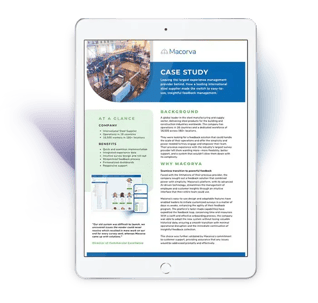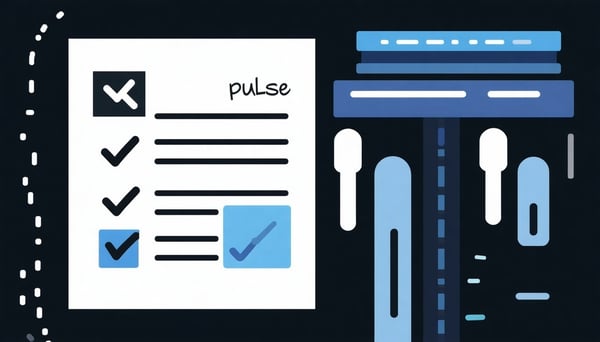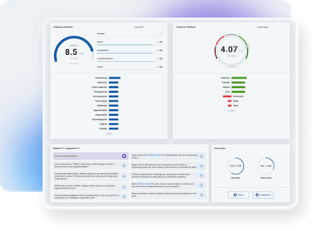
Micro-Feedback, Macro-Impact: How Real-Time Employee Feedback Drives Gen Z Engagement in Hybrid Teams
The annual performance review is failing your newest employees. Gen Z (born after 1996), a generation raised in a world of instant access and constant connection, expects a continuous feedback loop. For them, a once-a-year review isn't just outdated, it’s a primary driver of disengagement in today's hybrid workplace.
This expectation gap is especially damaging in remote and hybrid work environments, the very models preferred by 65% of Gen Z workers. However, micro-feedback offers a practical solution. When implemented thoughtfully, it helps re-engage Gen Z workers by creating a culture of engagement, validation, and continuous learning.
This article explores micro-feedback systems, how they solve the shortcomings of conventional feedback structures, and how your company can use today's tools to build a real-time employee feedback program that drives continuous improvement and recognition.
 1. Annual Reviews are Obsolete for Gen Z
1. Annual Reviews are Obsolete for Gen Z
Annual performance reviews, once a cornerstone of employee performance management, are no longer an effective defense against disengagement. According to recent Forbes surveys, Gen Z is far less likely than past generations to respond to annual reviews, which they view as “judgment,” compared to more frequent and personalized feedback. For Gen Z, a deep familiarity with social platforms like TikTok, Twitter, and Discord has made the desire for instant feedback integral to workplace motivation and productivity.
Despite improvements in overall engagement, research from Gallup shows that remote and hybrid employees have seen their engagement levels stall compared to their on-site teammates. In these environments, feedback is rarely natural or spontaneous as a quick motivational word in a hallway or a chat with a colleague. This disengagement may seem inherent to remote systems of feedback, but it is not inevitable. By shifting feedback structures to promote a continuous feedback loop between leaders and employees, businesses can deliver more frequent and, more importantly, more meaningful course corrections.
2. What is Micro-Feedback?
Micro-feedback is focused and frequent feedback that forgoes formal evaluations and lengthy surveys for more gratifying, social, and actionable feedback systems. It often consists of three simultaneous feedback types:
- Sentiment Nudges: Leadership can check in with teammates individually after a milestone, assignment, or other event with quick, visual forms of encouragement, such as an emoji or a short, positive note.
- Pulse Surveys: These brief surveys of 1-3 questions can be delivered through mobile apps or company workforce systems to take the “pulse” of employee engagement.
- Shout-outs: Teammates can recognize each other in collaboration platforms like Microsoft Teams or Slack groups to help employees realize that they are validated and part of a group, even in a remote setting.
Many organizations hesitate to drastically change time-honored performance review systems. However, micro-feedback is not simply a way for companies to chase social trends and try to prove to employees that leadership “gets” them; it's a strategic approach grounded in compelling research on what truly motivates the modern workforce.
For example, research from Harvard highlighted the idea of “small wins” as a primary psychological driver in today’s students and employees. They found that consistent, incremental wins were more motivating than infrequent ones, no matter how significant. Micro-feedback therefore, is not a popularity tactic but a strategic shift that uses frequent check-ins and real-time recognition to create a system of high-value employee feedback, capitalizing on the power of these small, motivating moments.
3. Tech That Enables Real-Time Feedback
Effective real-time feedback demands a technology stack that supports it. While mobile push notifications can be used for quick surveys, truly engaging remote employees often requires deeper integration. Modern workflows integrate chatbots into messaging platforms like Slack and MS Teams to collect feedback through prompts, use pulse survey software to deliver feedback through apps or email, and use AI to customize their performance management based on sentiment trends.
When operating properly, push-triggered check-ins reduce manager response times while improving visibility. This is another area where micro-feedback differs from traditional systems. Quarterly or annual feedback reviews are an obligation for everyone involved. In contrast, micro-feedback makes the process easier to give and more enjoyable to receive. Most importantly, it restores the kind of real-time recognition and validation that modern employees, especially remote ones, often miss in their daily workflows.
4. Proof Points & Competitive Gap
An overwhelming 84% of the Gen Z workforce prefer more frequent coaching-style conversations over conventional performance assessments. Meanwhile, data from the OC Tanner Institute reports that employees who receive frequent recognition are 38% less likely to leave their jobs. To maintain a competitive edge, organizations are refocusing feedback mechanisms on the demographic most likely to leave and most receptive to changes in their feedback workflows.
The data points away from isolated performance criticism and toward a more nuanced approach that embraces a continuous feedback loop. This aligns with the finding that 89% of Gen Z workers consider purpose-driven work an essential aspect of their engagement, since these workers thrive on receiving continuous, real-time validation. This need for immediacy is critical: recent studies show 3 in 4 Gen Z employees expect weekly feedback to receive immediate recognition and actionable course corrections.
The companies that fail to deliver a culture of investment valued by the Gen Z workforce risk losing these workers to disengagement and turnover. They expect their real-time sentiments to be heard, acknowledged, and acted upon. This means adapting a performance management system that accommodates what McKinsey calls “the nuanced and less tangible aspects of their contributions.”
How can an organization build an actionable, real-time feedback culture that satisfies Gen Z expectations? What are the qualities in a feedback system that can make intangible employee contributions seen and validated?
 5. How to Build a Real-Time Feedback Culture
5. How to Build a Real-Time Feedback Culture
Micro-feedback is a significant part of how organizations can answer these questions and build a real-time feedback culture that responds to modern workers’ need for social validation. However, it is not a complete solution for the challenges of maintaining a continuous feedback loop, employee non-participation, leadership hesitance, and technology that fails to deploy successfully.
Organizations can follow these five steps to give their leadership the best chance of building a real-time feedback culture that employees will want to engage with and managers will want to deploy:
Secure Leadership Buy-In
For any meaningful change to occur, an organization’s leadership must first recognize the need for a new approach to engaging the Gen Z workforce before any meaningful strides can be made in improving performance feedback mechanisms. According to the Niagara Institute, Gen Z employees are motivated by four key factors, which leadership must be able to communicate:
- Digital fluency
- Value-driven tasks
- Transparent communication
- Authentic leadership
Gen Z has experienced far more economic uncertainty and civil unrest than their older millennial coworkers. Because of this, they use more technology, think more about issues, and desire more value alignment in their organizations. This mindset directly impacts retention: 3 in 4 report that they would change organizations to one better aligned with their values; almost the same amount said they would leave a job without frequent coaching from their leadership.
If leaders are aware of the risks to retention rates and productivity, they can be better prepared to invest in the new feedback mechanisms designed to address them.

Select Tech Stack
Even with modern feedback structures, organizations may fail to see a significant ROI without the right technology to support them. For example, while making feedback systems accessible via mobile devices is a crucial first step, the tools themselves must be optimized for a mobile experience to be truly effective with Gen Z workers.
Mobile-first feedback systems prioritize accessibility with features like a clean mobile interface, integrations with team-building apps like Slack, and support for pulse survey software and tools for quick sentiment gathering, such as emojis. When combined with AI analysis to help leaders contextualize their feedback data and suggest courses of action, this technology prepares businesses to keep Gen Z employees feeling satisfied in their current positions.
Pilot and Calibrate
New feedback systems can be introduced gradually to help employees appreciate the change without being overwhelmed; this also helps leadership gauge their workers’ responses and adjust accordingly before deploying at scale. For example, a single department could transition from quarterly assessments to weekly micro-surveys to demonstrate the benefits and remaining pain points in terms of real-world data. During the pilot run, track these key factors to measure success:
- Sentiment changes over time
- Response rates
- Manager satisfaction
- Employee engagement KPIs
The feedback system should only be scaled once the pilot shows a clear improvement in engagement and an acceptable level of employee accessibility. A response rate of 70% or higher is a good benchmark to make sure the new system will be worth the transition.

Manager Enablement
This step involves using quick, targeted learning, or micro-learning, to improve the overall workflow for managers, including coaching prompts that can equip them with methods for improving their leadership strategies. In advanced performance management systems, this can include:
- Dashboards that show their team’s sentiment trends and automatically update them to reflect changes.
- AI analysis of feedback with suggested conclusions, conversational coaching prompts, and recommended strategies.
- Micro-learning modules for leaders, in addition to those provided to team members, to help improve coaching and leadership skills.
Since micro-feedback is quick and accessible, leaders can complete it without feeling scrutinized by a “performance assessment.” Ultimately this process of micro-feedback in a leadership context builds a direct line of communication between team members’ feedback and managers’ actions.
Communicate Wins
Celebrating small wins plays on the brain’s desire to make meaningful progress, which life coaches advise even in an individual setting as a way to break procrastination cycles, get motivated, and reinforce positive behavior. This psychology translates directly to successful engagement since, as Harvard Summer School described, small wins help people hone skills, maintain focus, set goals, prioritize their tasks, organize their workflows, and achieve a sense of purpose. To leverage this principle for real-time coaching in both on-site and remote work settings, your feedback system must encourage and amplify recognition through weekly or even daily interactions.

6. Measuring Impact
Once deployed, your feedback system must be monitored to gauge its impact on engagement KPIs, including:
- Pulse participation, which signals how relevant and trustworthy employees perceive the feedback to be
- Retention rate, which tracks shared values, retraining costs, and overall engagement
- eNPS, which tracks employee satisfaction, an important engagement factor, though not a replacement for it
- Manager response time, which suggests the effectiveness of leadership training and AI-driven dashboards
- Productivity per FTE, which directly connects the feedback system to real-world output
Recent Gallup studies suggest frequent feedback has the most measurable impact on engagement, more so than an employee’s on-site or remote status. A full 80% of employees who reported receiving meaningful feedback at any point in the week prior to being surveyed also reported being fully engaged in their work. This was shown to be just as true for on-site employees who spent every day in the office as for hybrid workers who only came in once or twice a week.
The true impact of these systems lies in their ability to translate data into tangible business value, fast. For example, clients using Macorva’s feedback system have demonstrated as much as a 3000% increase in ROI from AI coaching systems, with full-scale employee engagement survey deployment possible within weeks not months. Using our systems, managers were able to complete over hundreds of actions within just one month of receiving their team’s feedback results. That level of responsiveness is what separates market leaders from the competition
 7. Overcoming Common Challenges
7. Overcoming Common Challenges
Despite the measurable benefits of frequent micro-feedback, replacing conventional performance review systems leads to challenges. One of the biggest is ensuring recognition is meaningful. According to Gallup research, only around 1 in 10 employees are asked by their leadership how they would like to be recognized for their work. This means that even in industries where the benefits of feedback culture are recognized and acted upon, employee sentiments are not effectively valued. As a result, fewer than 1 in 4 workers strongly agree that they receive the right amount of recognition.
To combat this engagement outlook, organizations should recognize and address these four key challenges of micro-feedback systems during the pilot phase of their deployment:
- Feedback fatigue: Restrict microsurveys to 3 questions and use varied formats to maintain interest
- Data overload: Use AI to auto-tag feedback themes and restrict direct alerts to once per week
- Skepticism and resistance: Use quick-win anecdotes and transparent follow-up action plans to contextualize the relevance of feedback
- Privacy and ethics: Guarantee practical anonymity by setting minimum group sizes (e.g., 5+) for reporting, and clearly display GDPR and CCPA compliance to address ethical concerns.
These challenges can be addressed over time with an adaptive approach to feedback management that creates a continuous learning loop between employees and leaders.

8. Future Trends
As feedback looks to the future, AI-driven tools will shape the next phase of employee engagement, moving beyond planning to predict sentiment trends based on performance data. Managers equipped with these tools can then deliver preventive coaching responses before an issue impacts productivity.
Sentiment data will be more widely integrated in general, with future platforms consolidating chat sentiments, email tones, calendar patterns, and pulse data, into a single real-time view of employee well-being. As this data becomes more complex, the user experience (UX) for interacting with it becomes critical. This implies a growing need for Gen Z-focused UX design as millennials progress to leadership roles and Gen Z makes up more of the active workforce. This may mean more GIF reactions, emojis, swipe-based UIs, and more visually-driven feedback formats adapted for mobile-first employees.
Forward-thinking companies will proactively respond to these trends by linking feedback systems to internal mobility dashboards that show how individual workers are contributing to growth. This comprehensive, closed loop of recognition, skill development, and career planning will drive the success of real-time employee feedback systems in promoting hybrid team engagement in 2025 and beyond.
 9. Macorva’s Rule
9. Macorva’s Rule
Macorva is uniquely designed to create a real-time employee feedback culture that addresses Gen Z engagement challenges and helps you successfully transition from conventional assessments to regular micro-feedback.
- Radiant AI allows managers to act on real-time data output from pulses and sentiment trends by processing the data and creating actionable coaching prompts and suggested recommendations.
- Robust + mobile-first integration ensures that feedback systems fit naturally in the daily workflows of modern employees through tools like Slack chatbots, pulse surveys, and peer-to-peer shout-outs.
- Privacy-first design helps organizations maintain data management compliance, improve employees’ psychological safety factors and builds trust by guaranteeing anonymity.
- Unified analytics combine survey data, sentiment trends, trending topics, and even individual career pathing to proactively measure and respond to workforce engagement patterns.
Organizations that deploy Macorva’s feedback systems experience sustained increases in eNPS, higher manager responsiveness, and increased Gen Z engagement across multiple feedback KPIs. By offloading the labor of real-time feedback management to advanced AI systems, businesses can reduce the cost of system deployment while providing leadership with actionable strategies for their workforce.
Partner with Macorva for Data-Driven Insights into Modern Employee Engagement
Micro-feedback is not just a trend for engaging Gen Z workers. It represents the next step in feedback evolution away from restrictive and infrequent assessments and toward a sentiment-based, real-time employee feedback culture that scales better, makes employees feel more valued, and increases the precision and clarity of managerial insights with real-world data.
For the modern organization, Macorva’s Radiant AI is the intelligent engine that powers real-time feedback at scale. It analyzes employee sentiment trends across the entire workforce to provide leadership teams with clear, actionable insights for strategic decision-making. The platform is built on a mobile-first design to maximize adoption across a multigenerational workforce, engaging Gen Z without alienating other employees. By integrating into your existing enterprise tools like Slack and Teams, it seamlessly deploys scalable feedback features, from pulse surveys to peer recognition, across the entire business.
If your organization is ready to adopt micro-feedback and build a more resilient and responsive feedback culture, schedule your 10-minute demo to learn how Macorva can help.
FAQs About Micro-Feedback
The question types that work best for Gen Z are concise, relevant, and actionable. They also respond well to formats that include sentiment-based tools like personalized reactions and emojis.
Preventing anonymity concerns in feedback requires two key steps: clearly communicate your data protection policies and enforce a minimum group size (e.g., at least 5 respondents) to prevent singling out individuals.
Managers should act on feedback quickly, acknowledging it within one week of receiving the survey results. This timing ensures the feedback feels relevant to current tasks.
To avoid feedback fatigue from frequent pulse surveys, it's best to keep them under 60 seconds, vary the formats, and share follow-up actions that show participation is valued.
The main difference between micro-feedback and traditional surveys is frequency and tone. Unlike traditional surveys, which are often infrequent and feel critical, micro-feedback is a short, frequent, and continuous process designed to help tech-driven employees get quick recognition and stay connected to their team and goals.




